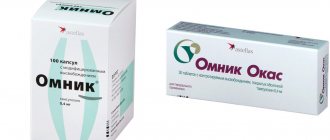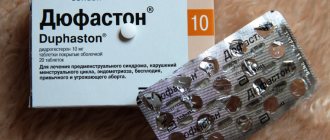Description of the drug
When taking Diphenhydramine, the effect is provided by the main substance – diphenhydramine.
Diphenhydramine can be purchased in the form of tablets with a dosage of 30, 50 or 100 mg or an injection solution with a concentration of 1% and a volume of 1 ml. Each package consists of 10 tablets or ampoules. Diphenhydramine is also available in the form of powder, eye drops, rectal suppositories, gel and stick for external use. The medicine may be produced in combination with other medicines.
When taken orally, diphenhydramine is effectively absorbed and reacts with proteins with almost one hundred percent activity. The highest concentration in the body occurs 20-40 minutes after administration, the effect lasts up to seven hours. The half-life from the body is 7 hours in children and 12-17 in adults.
Diphenhydramine acts as a reversible agonist of histamine H1 receptors. By competing with histamine for receptors, it weakens its effect in tissues, thereby alleviating allergic reactions. Penetrating the blood-brain barrier, where it has a similar effect on H1 receptors in the central nervous system, causing drowsiness.
Diphenhydramine also blocks intracellular sodium channels, temporarily suppressing the formation of action potentials in pain nerve endings, causing local anesthesia. Because of this, numbness of the mouth may occur when used internally.
The bulk of metabolism occurs in the liver tissue , most of it is excreted through urine, about 6% through feces. When the drug is used by a mother who is feeding a child, it passes into breast milk and can have a calming effect on the baby.
Features of the drug Diphenhydramine in ampoules
Diphenhydramine has been a popular medication for several decades. It effectively blocks the synthesis of histamines, which prevents the development of an allergic reaction. The use of Diphenhydramine in injections is also indicated to eliminate the symptoms of a number of other pathological diseases.
Release form and composition
The medicinal solution for intramuscular and intravenous administration is available in glass ampoules of 1 ml. The main active component of the drug is diphenhydramine hydrochloride.
pharmachologic effect
The therapeutic properties of the drug are due to the blockade of H1 receptors in the brain. The effect of Diphenhydramine on the body is due to its inhibitory effect on cholinergic structures.
When used, Diphenhydramine in ampoules has sedative, analgesic and hypnotic effects.
After administration of the drug, positive changes in the patient’s condition are quickly observed:
- smooth muscles relax;
- vascular permeability decreases;
- swelling is eliminated;
- irritation, itching and hyperemia decrease;
- allergic rash goes away.
When the active substance acts on the receptors of the vomiting center of the medulla oblongata, their sensitivity decreases, resulting in a decrease in the number of urges to vomit.
Diphenhydramine also has a local anesthetic effect.
The maximum concentration of the drug in the blood is achieved quickly. Within 10-15 minutes, negative symptoms are eliminated and the patient’s condition improves. The therapeutic effect lasts up to 12 hours. The breakdown products of the active substance are removed from the body by the urinary system.
Indications and contraindications
Diphenhydramine medicinal solution is prescribed if:
- allergic reaction;
- Quincke's edema;
- serum sickness;
- Meniere's syndrome;
- allergic conjunctivitis;
- itchy dermatosis;
- acute iridocyclitis;
- chorea and parkinsonism;
- radiation sickness;
- vasomotor rhinitis;
- rhinosinusopathy;
- hemorrhagic vasculitis;
- extensive post-traumatic damage to the skin and soft tissues.
Diphenhydramine is used for sleep problems, because the drug helps you fall asleep quickly. The product has a good effect against seasickness and air sickness.
The use of a medicinal solution for injection has a number of limitations. It should not be taken for the following pathological conditions:
- individual intolerance to components;
- glaucoma;
- narrowing of the bladder neck;
- bronchial asthma;
- prostatic hyperplasia;
- epilepsy.
The drug is not prescribed for stomach and duodenal ulcers, gastritis in the acute stage, heart rhythm disturbances, porphyria. The drug should not be used in children under 6 months of age. You should refrain from using the medicine during pregnancy and breastfeeding.
Instructions for use of Diphenhydramine in ampoules
To avoid unwanted reactions from the body, you should strictly adhere to the recommended doses and treatment regimen.
Directions for use and doses
The drug can be administered intramuscularly and intravenously. When used intravenously, the therapeutic effect is achieved faster.
When using Diphenhydramine, injection solution should be used in accordance with the recommendations:
- 6 months-1 year - 3-5 mg;
- 1-3 years - 5-10 mg;
- 4-6 years - 10-15 mg;
- 7-14 years - 15-30 mg;
- from 15 years and adults - 30-50 mg.
The daily dose is divided into 2-3 times. The treatment period is determined individually by the attending physician and depends on the type of pathology and the severity of symptoms.
You can drink Diphenhydramine in ampoules
If necessary, you can take the medicinal solution orally. But the effect of such treatment will be several times weaker than when using the injection method of administration.
Side effects and overdose
The use of Diphenhydramine injections can cause undesirable reactions from the body, including:
- disruption of the digestive process, accompanied by nausea, vomiting, diarrhea, stool retention, dry mouth;
- problems with urination;
- disruption of the menstrual cycle;
- hemolytic anemia;
- heart rhythm disturbance;
- blood pressure surges;
- dryness of the mucous membranes of the upper respiratory tract;
- dizziness;
- tremor of the limbs;
- drowsiness;
- increased irritability;
- paresthesia;
- neuritis;
- convulsions;
- agranulocytosis;
- decreased psychomotor reactions;
- violation of movement coordination.
Sometimes an allergic reaction develops in the form of skin dermatitis, itching, hyperemia, swelling and increased photosensitivity of the skin.
If the recommended doses of the drug are exceeded, an overdose is possible. Symptoms of this condition are:
- increased excitability;
- depression;
- dilated pupils;
- dry mouth;
- development of paresis of the gastrointestinal tract.
In such cases, the stomach is washed and medications are used to eliminate the negative symptoms.
Special instructions and precautions
Before starting therapy, you must carefully read the instructions and administer the medicine, strictly following the recommendations.
During the course of treatment with Diphenhydramine, you should not sunbathe or visit a solarium. The simultaneous use of ultraviolet rays and a therapeutic substance leads to the development of side effects.
You should avoid activities that require increased concentration and driving, as the medication slows down mental and motor reactions.
Diphenhydramine should be used with caution for the treatment of newborns and premature infants. Taking antihistamines can cause convulsions and hallucinations. In some cases, the drug helps to reduce the child’s mental activity or leads to overexcitation.
Use during pregnancy and lactation
It is not recommended to use the medicinal solution during pregnancy or breastfeeding. If such a need arises and there is no alternative, injections are used with caution and under the strict supervision of the attending physician.
Drug interactions and compatibility with alcohol
Diphenhydramine enhances the effect of medications that have a depressant effect on the central nervous system. When taken together with monoamine oxidase inhibitors, the activity of diphenhydramine increases. Diphenhydramine injections reduce the therapeutic effect of the emetic Apomorphine, which is widely used for poisoning.
The drug must not be used with the following drugs:
- barbiturates;
- Cefmetazole sodium;
- Hydrocortisone succinate;
- Ampholip;
- Amphotericin B;
- solutions of alkalis and strong acids.
During treatment with injections, you should not drink alcohol, so as not to provoke the development of negative reactions from the body.
Conditions of sale and storage
The therapeutic agent can be purchased at the pharmacy with a doctor's prescription. Store the drug in a cool and dark place out of reach of children. Shelf life: 5 years.
Analogs (briefly)
If necessary, Diphenhydramine can be replaced with other drugs that are similar in composition and therapeutic effect. Among the most popular substitutes:
- Analdim. Includes the additional component metamizole sodium, which has a pronounced analgesic effect. Has a fast and effective effect. Available in the form of rectal suppositories.
- Dermadrin. The ointment contains diphenhydramine, which has methaneesthetic, cooling, antiallergic and analgesic effects.
- Kafanol. An antihistamine used systemically. Its active ingredients include diphenhydramine, ammonium chloride, sodium citrate and menthol. When used, the syrup produces sedative, hypnotic, antiparkinsonian and antiemetic effects.
- Flurex. It has antihistamine, antipyretic and analgesic properties. The medicine contains paracetamol, ascorbic acid and diphenhydramine hydrochloride. It relaxes smooth muscles well, reduces pain, eliminates allergies and strengthens the immune system.
Replacing Diphenhydramine with a similar medication should only be carried out by the attending physician, taking into account the type of pathology, the severity of symptoms and the individual characteristics of the patient’s body.
Source: https://oVakcine.ru/inekciya/osobennosti-preparata-dimedrol-v-ampulah
Indications for use
Due to the broad systemic effect on the body of drugs containing Diphenhydramine, indications for use include a large number of conditions . It is prescribed alone or in combination with other medications:
- for various types of allergies: hay fever, rhinitis, urticaria, angioedema;
- as a local anesthetic for people allergic to lidocaine;
- as part of a radiation therapy complex;
- for skin lesions, burns, dermatosis;
- to relieve insomnia, seasickness;
- as a sedative;
- to relieve extrapyramidal symptoms, including in the treatment of Parkinson’s disease;
- to lower the temperature in extreme heat;
- as an antiemetic drug for pregnant women.
Area of use of antihistamine
The instructions recommend using the medicine “Diphenhydramine” (in ampoules) during the treatment of vasomotor rhinitis, acute forms of iridocyclitis, hay fever, urticaria and allergic conjunctivitis. In addition, this antihistamine and anti-inflammatory agent is indicated for use in itchy dermatoses, capillary toxicosis, serum sickness and angioedema. After transfusion of blood and various fluids that replace it, it is similarly recommended to use the ganglion-blocking drug Diphenhydramine.
Injections with this medicine are also prescribed in the event of the development of allergic complications after one or another drug therapy. In addition, this antihistamine helps very well with anaphylactic shock, radiation sickness, stomach ulcers, bronchial asthma, premedication, parkinsonism, sleep disorders, hyperacid gastritis, colds, chorea, Meniere's syndrome, extensive injuries of the skin and soft tissues, sea or air diseases. Finally, quite often this local anesthetic drug is used during local anesthesia in patients who have previously experienced allergic reactions to other local anesthetic drugs.
Contraindications
Diphenhydramine should be used with extreme caution in the following conditions:
- individual sensitivity;
- angle-closure glaucoma;
- liver diseases;
- ulcerative lesions of the stomach and intestines;
- for lung diseases, especially bronchial asthma;
- epilepsy.
Due to the presence of side effects such as drowsiness and decreased attention, it is not recommended to perform work with increased responsibility that requires concentration (for example, driving a car) during treatment. It is undesirable to be exposed to ultraviolet radiation or to be in the open sun. Consumption of alcoholic beverages is prohibited. Also, when using diphenhydramine with some other medications, consultation with a doctor is required, as it tends to enhance their hypnotic, tranquilizing effect and further suppress the nervous system.
A paradoxical effect has been described, most often in children, consisting of an opposite, exciting reaction.
For a complete list of incompatible substances, please refer to the enclosed instructions.
Diphenhydramine
The recommendations were compiled by a pediatrician - Dr. Victor Abdow Rockville, MD, USA.
Is it possible to take Diphenhydramine during lactation? Is it safe for nursing mother and baby?
This is the first antihistamine of a new generation (Ethanolamine) with a strong sedative effect. High protein-binding capacity makes it difficult to excrete in breast milk in significant quantities according to old studies that confirmed this. Absorption from maternal intake
Very low risk Allowed during breastfeeding. Not dangerous for the baby. more details.
Low risk Moderately safe. May be present in breast milk. Follow your doctor's advice. more details.
High risk Unsafe drug; risks must be assessed when taking it. Use safer alternatives. more details.
Very high risk Not recommended. You need to stop breastfeeding or choose a safe alternative. more details.
Very often, the reason why a baby is deprived of valuable milk is the mother’s illness. Some people stop feeding even because of a minor cold. But is this really necessary?
Breast milk does not contain bacteria and therefore cannot make the baby sick. But it provides the child with unique protection against infections, allergies, and also stimulates the development of its own immune system. It contains:
- live leukocytes, lymphocytes and macrophages, as well as lysozyme with a bactericidal effect
-antibodies (immunoglobulins) that protect the child from infections and correct the inferiority of his immunity
— Bifidus factor, which stimulates the growth of Lactobacillius bifidus in the child’s intestines, and also counteracts the colonization of the intestines by pathogenic flora
- Lactoferrin, which binds iron and can also prevent the growth of some bacteria
- factors circulating between the bronchi and mammary gland, performing immunological functions and stimulating the production of antibodies to infection entering the child’s body from outside.
Some time passes from the moment the pathogen enters a woman’s body until the first signs of the disease appear. Already during this period, the mother can infect others without knowing that she is sick. But at this time, her body produces protective antibodies, which the baby receives through milk. As a result, the child either does not get sick at all or tolerates the disease more easily and without complications, unlike a child who has been weaned.
Because breast milk is a source of unique, personalized medicine, breastfeeding should be maintained if the mother is ill.
In fact, milk decreases not due to illness, but due to a decrease in milk supply. Sometimes, if a woman has a very high temperature, she loses a lot of fluid through sweat and her milk supply decreases. To prevent this from happening, you must:
During illness, feed at the same frequency (on demand)
Increase fluid intake
If it is difficult for a mother to feed and express, the caregivers will be able to supplement with expressed milk, BUT from a spoon or cup (not a bottle), otherwise after recovery the mother may get a new problem - breast refusal.
In this case, the mother should express herself every 2.5-3 hours, and caregivers can feed the baby with expressed milk (see above).
If a woman is undergoing a mini-operation (opening a boil, dental treatment, mini-abortion), you can feed 6 hours after giving anesthesia. In case of surgery – after 12 hours. During this time, you need to express every 3 hours, but throw away the milk.
If a woman knows in advance about the upcoming absence, it is useful for her to know the shelf life of milk.
If milk has been heated or defrosted but not used, it cannot be stored again!
Breastfeeding is contraindicated in case of severe illness of the mother, for example, in case of heart failure, serious kidney, liver, lung diseases, in case of severe psychosis (due to the danger to the life of the child if there is no constant monitoring of the woman).
Viral infections such as rubella, chickenpox, measles and mumps do not require interruption of breastfeeding.
Detection of cytomegalovirus in a nursing mother is not a reason to stop feeding; on the contrary, breastfeeding is the primary form of immunization against this disease.
Breast milk may contain hepatitis B surface antigen, but there is no evidence that breastfeeding increases the risk of passing the infection to your baby.
Treat or feed?
Most medications pass into milk in small quantities, which are not harmful to the baby. Stopping breastfeeding can be far more dangerous than most medications.
There is a small group of drugs that can harm a child - anti-cancer drugs, antithyroid, radioactive substances, multiple doses of erot.
Reduce milk production: estrogens, thiazides.
The influence of certain pharmacological drugs
| Simultaneously expressed from one breast | Two portions | |
| Up to 25 Cº | 8 ocloc'k | 3-4 hours |
| In a refrigerator | Up to 36 hours | Till 12 o'clock |
| In the freezer | Up to 6 months | Up to 2 months |
Contraindicated during breastfeeding, Possible drowsiness, weakness, sweating, lack of weight gain, Taking more than 1 g/kg/day causes inhibition of the mother's milk ejection reflex
Usually not contraindicated during breastfeeding. All antibiotics pass into milk in small quantities and are safe for the newborn, since they are not absorbed in the intestines, and diarrhea is possible.
Usually not contraindicated during breastfeeding. Use with caution in case of phenylketonuria.
Usually not contraindicated during breastfeeding. Excitement, poor sleep, and feeding difficulties are possible.
During breastfeeding, administration of the drug should be discontinued. There is a risk of gastrointestinal bleeding. Breastfeeding can be resumed only 24 hours after discontinuation of the drug.
| Alcohol | |
| Aminoglycosides | |
| Insulin | Usually not contraindicated during breastfeeding. |
| Levomycytin | During the feeding period, treatment with the drug should be discontinued. There is a risk of toxic damage to the bone marrow. Feeding can be resumed only 24 hours after discontinuation of the drug. |
| Paracetamol | not contraindicated during breastfeeding. |
| Aspirin | In single doses it is compatible with breastfeeding. If possible, do not use. |
| Prednisolone | Usually not contraindicated during breastfeeding |
| Tetracyclines | Should not be used. Dark yellow discoloration of teeth and growth retardation may occur. |
| Phenobarbital | Usually not contraindicated during breastfeeding. Possible disturbance of sucking, depression of the central nervous system and the appearance of a rash |
| Cimetidine | Contraindicated. May reduce the acidity of gastric juice in a newborn, disrupt the metabolism of drugs and cause stimulation of the central nervous system. |
| Furosemide | Do not use if possible |
If a nursing mother gets sick, she should follow several rules:
Do not self-medicate; treatment should be prescribed by a doctor, not a pharmacist or a friend.
If the mother is worried about the prescribed drug, she should ask the doctor to talk about the possible effect on the baby or ask to prescribe an alternative drug.
The child should be monitored for side effects.
Make maximum use of the possibilities of gentle treatment: physiotherapeutic methods, restoratives, aromatherapy, homeopathic treatment.
Take medications during or immediately after feeding to avoid the period of maximum concentration in the blood.
To relieve allergy attacks and swelling, Diphenhydramine is used in tablets or injections. This drug causes drowsiness and therefore has restrictions on its use. Its use is common in complex therapy with other medications, which together give a successful treatment result. Read the instructions for use of the medication.
Side effects
Diphenhydramine is a strong anticholinergic agent and has side effects such as:
- feeling of dry mouth and mucous membranes;
- tachycardia;
- dilated pupils;
- urinary retention and constipation;
- hallucinations and delirium (in case of overdose);
- skin redness;
- sensitivity to bright light;
- difficulty concentrating, problems with short-term memory;
- irritability;
- temporary erectile dysfunction.
When used by children under six years of age, nursing women and people over sixty years of age, consultation with a doctor is required.
Pharmacological properties
Pharmacodynamics
It has antihistamine, antiallergic, antiemetic, hypnotic, and local anesthetic effects. Blocks histamine H1 receptors and eliminates the effects of histamine mediated through this type of receptor. Reduces or prevents histamine-induced smooth muscle spasms, increased capillary permeability, tissue swelling, itching and hyperemia. Causes local anesthesia (when taken orally, a short-term numbness of the mucous membranes of the oral cavity occurs), blocks cholinergic receptors of the autonomic ganglia (reduces blood pressure). The effect on the central nervous system is due to the blockade of H3-histamine receptors in the brain and inhibition of central cholinergic structures. Causes sedative, hypnotic and antiemetic effects. Antagonism with histamine manifests itself to a greater extent in relation to local vascular reactions during inflammation and allergies than to systemic ones, i.e. decrease in blood pressure. In people with local brain damage and epilepsy, it activates (even in low doses) epileptic discharges on the EEG and can provoke an epileptic attack. It is more effective for bronchospasm caused by histamine liberators (tubocurarine, morphine), and to a lesser extent for bronchospasm of an allergic nature. Sedative and hypnotic effects are more pronounced with repeated doses. The onset of action is noted 15-60 minutes after oral administration, duration - up to 12 hours.
Pharmacokinetics
When taken orally, it is quickly and well absorbed. Binds to plasma proteins by 98-99%. The maximum serum concentration (Cmax) after oral administration is reached within 1-2 hours, then for about another 2 hours the concentration remains at the same level, and then quickly decreases; the half-life (T1/2) is 4-8 hours. The drug is distributed throughout all organs and tissues, including the central nervous system (the highest concentration is determined in the lungs, spleen, kidneys, liver, brain and muscles). Penetrates the placenta, significant amounts are found in breast milk and may cause sedation in breastfed infants (a paradoxical reaction characterized by excessive excitability may occur). Metabolized mainly in the liver, partially in the lungs and kidneys. Within 24 hours, it is completely excreted from the body mainly in the form of benzhydrol conjugated with glucuronic acid, and only in small quantities unchanged in the urine.
Overdose
Due to the availability and psychotropic effects of this drug, there are known cases of its use as a drug, both alone and together with other psychoactive substances to enhance their effects. This often leads to intoxication of the body and can cause serious harm, including irreversible harm. At excessively high doses, Diphenhydramine causes poisoning, which can be fatal due to disturbances in the functioning of the heart.
In case of overdose , increased side effects are observed, tremors, convulsions, inadequacy, hallucinations, increased heart rate, muscle spasms, including breathing problems. In the absence of help, the poisoned person may injure himself, fall into a coma, and may die due to respiratory and cardiovascular system disorders.
There are no special drugs to treat an overdose; gastric lavage and blood purification are used.
Long-term use is associated with an increased risk of dementia in older people and cognitive decline.
"Suprastin" and "Diphenhydramine" during pregnancy
First generation drugs, such as Diphenhydramine and Suprastin, act almost instantly, this is their huge advantage. And everything would be fine, but is it possible to take Diphenhydramine and Suprastin during pregnancy? The main thing here is to know the gestational age. Because if this is the first three months of pregnancy, then taking it is strictly prohibited. Diphenhydramine is so dangerous in the early stages of pregnancy that if taken inappropriately it can lead to the death of the fetus.
But the irony is that doctors, when allergy symptoms are frightening, most often prescribe it. Because they have this concept that the benefits may outweigh the risks. And when you take this drug, allergy symptoms will go away instantly. This prescription and the Diphenhydramine injection itself can be made during pregnancy strictly under medical supervision and in a hospital setting. And if something goes wrong, emergency medical attention will be required.
But during pregnancy in the 3rd trimester, Diphenhydramine and Suprastin can be used, but only as a last resort, since these drugs can cause premature birth, which is undesirable at any stage.
Dosage
For adults , when prescribing Diphenhydramine, the dosage ranges from 1 to 5 ml when administered intramuscularly or 30-50 mg when administered orally up to 3 times a day for 15 days. For children under one year old, 2 to 5 mg are prescribed, for children under five years old, from 5 to 15 mg, and for children under 12 years old, from 15 to 30 mg.
The maximum dose for an adult is 100 mg, while the total amount of the drug taken for the entire day should not exceed 250 mg. For a child, these figures are 50 mg and 150 mg, respectively. The maximum dose for parenteral administration is 5 mg at a time and 15 mg per day.
To eliminate sleep problems, it is recommended to take 50 mg half an hour before bedtime.
For seasickness, Diphenhydramine is taken in the amount of 25 to 50 mg, depending on the severity of the condition.
Rectal suppositories are used mainly for the treatment of children: up to 3 years, 5 mg is indicated, up to 4 years – 10 mg; from 5 to 14 years – from 15 to 20 mg several times a day.
Gels containing Diphenhydramine are applied to areas of skin with an allergic reaction several times a day.
Please read the enclosed instructions carefully before use.
special instructions
The medication has a negative effect on activities that require increased concentration, control of complex mechanisms, and driving vehicles. During therapy, it is necessary to avoid drinking alcoholic beverages and limit exposure to the sun and ultraviolet radiation to a minimum. The antiemetic effect of the drug may mislead the doctor in the differential diagnosis of acute appendicitis
, recognizing symptoms of overdose, intoxication.
Please tell your doctor or pharmacist if you are taking or have recently taken any other medicines, including medicines obtained without a prescription. Use of dermodrin ointment with food and drinks. No interactions were observed.
Pregnancy and breast-feeding Ask your doctor or pharmacist for advice before taking any medicines. Dermodrin ointment should not be used during the first 3 months of pregnancy. During the remainder of pregnancy, use on large surfaces should be avoided, especially in the case of wounds or trauma to the skin.
International name (INN) of Diphenhydramine: Diphenhydramine.
The Pharmacopoeia contains a description under FS 42-0232-07.
Described on Wikipedia under the name Diphenhydramine.
It is often necessary to know the name of a drug in Latin. Here, for example, is the recipe in Latin:
Rp.: Dimedroli 0.05
D. td N 10 in tabul. S.
Diphenhydramine sticks in Latin: baculi cum dimedrolum.
Dermodrin ointment should not be used during breastfeeding as the active substance passes into breast milk. Driving and using machineryDemor-oily does not affect the ability to drive and use machinery. Important information about some of the ingredients in Dermodrin Ointment.
If you are not sure, ask your doctor or pharmacist. Unless otherwise directed by your doctor, apply a cherry-to-walnut amount of Dermodrin ointment to the affected area of skin, depending on the size of the area being treated. Adults use 4 to 6 times a day, children - only 4-5 times a day. If complaints do not improve after two weeks of continuous use, you should inform your doctor.
Structural formula of the active substance:
Is Diphenhydramine a drug?
In fact, the medication is not a drug, but in combination with alcoholic drinks and in large doses it causes hallucinations, as well as addiction if used frequently.
Can I take Diphenhydramine in ampoules?
In general, it is possible, but the concentration of the active substance in ampoules is less than in tablets.
Price
Since diphenhydramine has been included in the list of essential drugs that are regulated by the state, Diphenhydramine can be purchased at affordable prices . The price range greatly depends on the manufacturer, form of release, composition and region. On average, a standard package of Diphenhydramine in tablets costs from 3 to 20 rubles, in ampoules - 20-30 rubles per package, gels - up to 300 rubles. A prescription is required to purchase.
The shelf life is five years from the date of release; the drug should be stored in an unlit place, protected from children, at a temperature below 25 ˚ C.
What can be replaced
Analogues of Diphenhydramine in ampoules are Tavegil, Suprastin, Chloropyramine. The cost of Tavegil in ampoules is about 200 rubles. Suprastin in the form of injections costs about 150 rubles. And Chloropyramine costs about 130 rubles. Their active ingredients are different, but the effects of these drugs are the same.
If a sane person does not independently replace a drug that is used in the form of injections, without the recommendation of his attending physician, then patients often choose tablets on their own. Although this is also unacceptable, since you can cause significant harm to your body. Therefore, we will consider several main analogues of Diphenhydramine in tablets.
Kalmaben
Antihistamine. The active component of the drug is diphenhydramine. Available in the form of white tablets. The medicine is intended for systemic use and has a hypnotic and sedative effect. In addition, the drug eliminates allergy symptoms. It is a good substitute for Diphenhydramine.
For patients over twelve years of age, it is allowed to take one tablet orally, about half an hour before bedtime, with a sufficient volume of liquid. The therapeutic course can last no more than two weeks. If necessary, the doctor may prescribe re-treatment. For allergies, medicine is prescribed for the same age category. The dosage in this case is 1 tablet no more than three times a day. Treatment lasts one and a half to two weeks.
The most common side effects include drowsiness and difficulty concentrating. There is a possibility of general weakness, headaches, and arterial hypotension. Sometimes the oral cavity may feel dry, vision blurred, nausea and a gag reflex appear, and deviations in urine output are observed. There are rare cases where allergies manifest themselves on the surface of the skin.
Improper use of this medicine leads to dependence on it.
In pharmacy kiosks, medicine is dispensed according to a doctor's prescription. Its cost is from 8 Russian rubles.
From reviews of patients who took Kalmaben, it follows that the medicine can create a lethargic effect the next day after taking it. This is especially pronounced if the sleep was short.
Dramamine
Another analogue of Diphenhydramine in tablets without a doctor’s prescription is a drug with an active substance called dimenhydrinate. The medicine creates an antiemetic and antinausea effect, prevents the synthesis of acetylcholine, eliminates dizziness, and has a sedative, anti-allergic, and local anesthetic effect.
Prescribed for:
- prevention or therapy of kinetosis, sea and airborne diseases;
- providing assistance in eliminating manifested deviations in the vestibular apparatus;
- eliminating dizziness and nausea;
- used in the treatment of Meniere's disease.
Patients over the age of twelve are prescribed 50–100 mg no more than three times a day. When preventing kinetosis, it is recommended to take the same dose half an hour before the trip. Dramamine is allowed to be taken per day in an amount not exceeding 400 mg.
Young patients whose age ranges from 1 to 6 years are prescribed from 12.5 to 25 mg of the drug, distributed over three doses. Older children can be given 25–50 mg three times a day. The dosage of the drug can be set and adjusted by the attending physician. The medication should be taken before meals.
Dramamine should not be used by patients who have individual sensitivity to the components of the drug, those suffering from epilepsy, seizures, acute dermatosis, children under one year of age, women during pregnancy and nursing mothers.
Particular care must be taken in patients suffering from angle-closure glaucoma, hyperplasia, gastrointestinal ulcers, and cervical obstruction.
In case of an overdose, a feeling of dryness appears in the nose and mouth, breathing slows down, and confusion appears in consciousness. In such situations, it is recommended to urgently rinse the stomach and take activated charcoal.
This drug can be purchased at the pharmacy without a prescription, its cost is from 130 Russian rubles. The price depends on the manufacturer and packaging.
Many patients claim that Dramamine eliminates symptoms, but does not cure the disease itself. Before you start taking this drug, you should consult your doctor to determine the dosage that is right for you.
In any case, when choosing what to replace Diphenhydramine with, you should follow the recommendations of your doctor.
Everyone knows that for insomnia and anxiety, Diphenhydramine is used for sleep. In addition, this drug has antihistamine, analgesic and antispasmodic effects. In order for a drug to have the desired effect on the human body, you need to know its indications, as well as possible side effects.









